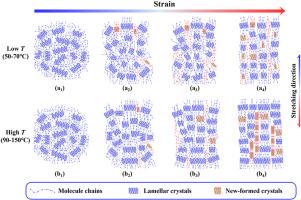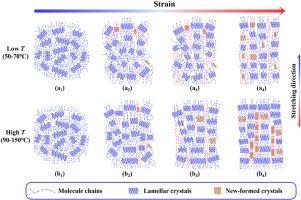Structural evolution of poly(glycolide-co-lactide) under stress-temperature coupled fields based on in-situ WAXD/SAXS
IF 4.5
2区 化学
Q2 POLYMER SCIENCE
引用次数: 0
Abstract
As one of the most promising biodegradable polymeric materials, P(GA-co-LA) has become a hot research topic due to its excellent biocompatibility, tunable degradation properties and good mechanical performance. In this study, the synchrotron in-situ WAXD/SAXS techniques were employed to systematically investigate the evolution of the aggregated state structure of highly crystalline P(GA-co-LA) with an LA content of 8 mol% during hot-stretching at temperatures ranging from 50 °C to 150 °C. The research results indicate that the initial eutectic structure of P(GA-co-LA) significantly influences its stretching-induced structural evolution, exhibiting distinct temperature-dependent structural evolution characteristics: under low-temperature (50–70 °C) stretching conditions, crystal slip and fragmentation dominate, leading to a significant reduction in crystallite size; whereas under high-temperature (120–150 °C) conditions, enhanced molecular chain mobility promotes the formation of stress-induced highly oriented crystals. Notably, unlike the homopolymer PGA, P(GA-co-LA) does not exhibit significant cavitation during stretching at 70–150 °C, which is mainly attributed to the disruptive effect of LA units on the homogeneity of the amorphous regions. Moreover, under high-temperature stretching conditions, the free energy for the exclusion of LA units from the lattice decreases, and the increase in the unit cell parameter b is significantly reduced, indicating that the highly oriented crystalline structure effectively inhibits the reincorporation of LA units.


基于原位WAXD/SAXS的应力-温度耦合场下聚乙二醇-共丙交酯的结构演化
P(GA-co-LA)作为一种极具发展前景的生物降解高分子材料,因其优异的生物相容性、可调节的降解性能和良好的力学性能而成为研究热点。在本研究中,采用同步加速器原位WAXD/SAXS技术系统地研究了LA含量为8 mol%的高结晶P(GA-co-LA)在50 ~ 150℃热拉伸过程中聚集态结构的演变。研究结果表明:P(GA-co-LA)的初始共晶结构显著影响其拉伸诱导的结构演化,表现出明显的温度依赖结构演化特征:在低温(50-70℃)拉伸条件下,晶体滑移和破碎占主导地位,导致晶体尺寸显著减小;而在高温(120-150℃)条件下,分子链迁移率的增强促进了应力诱导的高取向晶体的形成。值得注意的是,与均聚物PGA不同,在70-150℃拉伸过程中,P(GA-co-LA)没有表现出明显的空化现象,这主要归因于LA单元对非晶区均匀性的破坏作用。此外,在高温拉伸条件下,LA单元从晶格中排除的自由能降低,单元胞参数b的增加明显减小,表明高取向的晶体结构有效地抑制了LA单元的再结合。
本文章由计算机程序翻译,如有差异,请以英文原文为准。
求助全文
约1分钟内获得全文
求助全文
来源期刊

Polymer
化学-高分子科学
CiteScore
7.90
自引率
8.70%
发文量
959
审稿时长
32 days
期刊介绍:
Polymer is an interdisciplinary journal dedicated to publishing innovative and significant advances in Polymer Physics, Chemistry and Technology. We welcome submissions on polymer hybrids, nanocomposites, characterisation and self-assembly. Polymer also publishes work on the technological application of polymers in energy and optoelectronics.
The main scope is covered but not limited to the following core areas:
Polymer Materials
Nanocomposites and hybrid nanomaterials
Polymer blends, films, fibres, networks and porous materials
Physical Characterization
Characterisation, modelling and simulation* of molecular and materials properties in bulk, solution, and thin films
Polymer Engineering
Advanced multiscale processing methods
Polymer Synthesis, Modification and Self-assembly
Including designer polymer architectures, mechanisms and kinetics, and supramolecular polymerization
Technological Applications
Polymers for energy generation and storage
Polymer membranes for separation technology
Polymers for opto- and microelectronics.
 求助内容:
求助内容: 应助结果提醒方式:
应助结果提醒方式:


